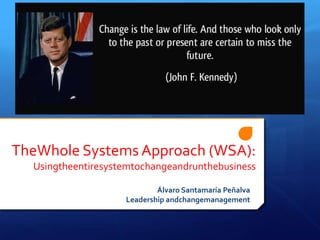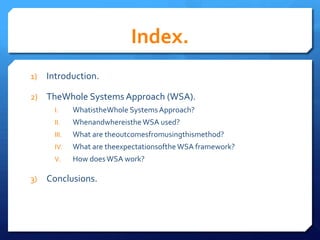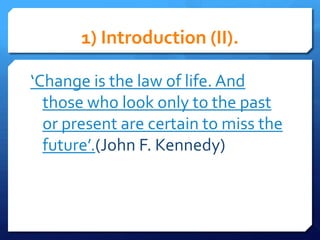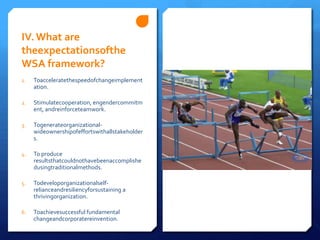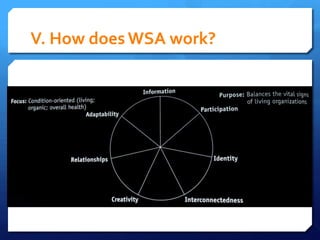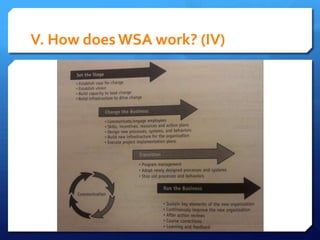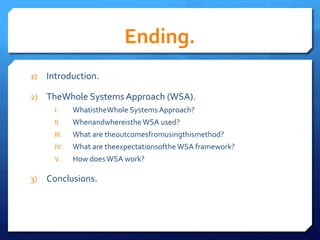The whole systems approach (wsa)
- 1. TheWhole Systems Approach (WSA): Usingtheentiresystemtochangeandrunthebusiness ├ülvaro Santamar├Ła Pe├▒alva Leadership andchangemanagement
- 2. Index. 1) Introduction. 2) TheWhole Systems Approach (WSA). I. II. Whenandwhereisthe WSA used? III. What are theoutcomesfromusingthismethod? IV. What are theexpectationsofthe WSA framework? V. 3) WhatistheWhole Systems Approach? How does WSA work? Conclusions.
- 3. 1) Introduction. STRUCTURING METHODS: Organizethesystemtocreatethedesir edfuture. 1. Redefinedrelationshipsamongpe ople. 2. Redesignedworkpractices.
- 4. 1) Introduction (II). ŌĆśChange is the law of life. And those who look only to the past or present are certain to miss the futureŌĆÖ.(John F. Kennedy)
- 5. 2) TheWhole Systems Approach (WSA).
- 6. I. WhatistheWhole Systems Approach? ’āŖ Framework foreffectivelyweavingmultipleorganizationalchangeinitiative sinto a well-designed, highlyeffective, coherentwhole. ’āŖ Purpose: Toachieveorganization-widechangeandlarge- scaleemployeeengagement, buy-in andresultsthroughenhancedleadership, andemployeecommi tmentandaccountability. ’āŖ Everystakeholderisinvolved in theprocess.
- 7. II. Whenandwhereisthe WSA used? ’ā╝ A needtofundamentallychangeortransformisevident. ’ā╝ A numberofexistingeffortsrequireintegrationinto a comprehensivewhole. ’ā╝ Large-scaleengagementofallconstituenciesisdesired. ’ā╝ A neworganizationalfocusisrequired. ’ā╝ A newpossibilitycouldpotentiallyyieldsignificantvalueorenhanc edcapability. ’ā╝ Currenteffortslackspeed, resultsorbroadownership.
- 8. III. What are theoutcomesfromu singthismethod? 1. Increasingleadershipeffectiveness. 2. Large-scaleengagement. 3. Creatingchangeableorganizations. 4. Producingexceptionalbusinessresu lts.
- 9. IV. What are theexpectationsofthe WSA framework? 1. Toacceleratethespeedofchangeimplement ation. 2. Stimulatecooperation, engendercommitm ent, andreinforceteamwork. 3. Togenerateorganizationalwideownershipofeffortswithallstakeholder s. 4. To produce resultsthatcouldnothavebeenaccomplishe dusingtraditionalmethods. 5. Todeveloporganizationalselfrelianceandresiliencyforsustaining a thrivingorganization. 6. Toachievesuccessful fundamental changeandcorporatereinvention.
- 10. V. How does WSA work?
- 11. V. How does WSA work? (II)
- 12. V. How does WSA work? (III)
- 13. V. How does WSA work? (IV)
- 14. 3) Conclusions. ’āŖ Companiesneedtolearnto be adaptable tothechangesoftheworldandthecustomers. ’āŖ Communication. ’āŖ Manyyears ago, companieswerefocusedontheproductandthedecissionsoftheb oardofdirectives. Nowadays, theythinkthecustomersandthecooperationamongthepe rsonnelis more important. ’āŖ Thesedays, conceptssuch as themotivationoftheworkersortheir training are reallyimportant. Thus, people are engagedonthecompany. ’āŖ Afteractionreviews; learningand feedback
- 16. Ending. 1) Introduction. 2) TheWhole Systems Approach (WSA). I. II. Whenandwhereisthe WSA used? III. What are theoutcomesfromusingthismethod? IV. What are theexpectationsofthe WSA framework? V. 3) WhatistheWhole Systems Approach? How does WSA work? Conclusions.
- 18. Bibliography: Edited by Holman, P.; Devane, T.; Cady, S.. ŌĆśThechangehandbook: TheDefinitiveResourceonTodayŌĆÖs Best MethodsforEngagingWhole SystemsŌĆÖ. 2nd ed. rev.andexpanded. San Francisco: BerrettKoehler, 2009. p-441-448. ISBN: 9781576753798.

